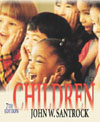John W. Santrock,
University of Texas, Dallas
| active (niche-picking) genotype-environment correlations | correlations that exist when children seek out environments they find compatible and stimulating.
(See 92)
|
 |
 |
 |
| adaptive behavior | behavior that promotes the organism's survival in its habitat.
(See 73)
|
 |
 |
 |
| adoption study | a study in which investigators seek to discover whether, in behavior and psychological characteristics, adopted children are more like their adoptive parents, who provided a home environment, or more like their biological parents, who contributed their heredity. Another form of the adoption study is to compare adoptive and biological siblings.
(See 80)
|
 |
 |
 |
| behavior genetics | the study of the degree and nature of behavior's heredity basis.
(See 79)
|
 |
 |
 |
| canalization | the process by which characteristics take a narrow path or developmental course. Apparently, preservative forces help to protect a person from environmental extremes.
(See 79)
|
 |
 |
 |
| chromosomes | threadlike structures that come in 23 pairs, one member of each pair coming from each parent. Chromosomes contain the genetic substance DNA.
(See 74)
|
 |
 |
 |
| DNA | a complex molecule that contains genetic information.
(See 74)
|
 |
 |
 |
| dominant-recessive genes principle | if one gene of a pair is dominant and one is recessive (goes back or recedes), the dominant gene exerts its effect, overriding the potential influence of the recessive gene. A recessive gene exerts its influence only if both genes in a pair are recessive.
(See 75)
|
 |
 |
 |
| evocative genotype-environment correlations | correlations that exist when the child's genotype elicits certain types of physical and social environments.
(See 92)
|
 |
 |
 |
| evolutionary psychology | the theory that emphasizes the importance of adaptation, reproduction, and "survival of the fittest" in explaining behavior.
(See 73)
|
 |
 |
 |
| genes | units of hereditary information composed of DNA. Genes act as a blueprint for cells to reproduce themselves and manufacture the proteins that maintain life.
(See 74)
|
 |
 |
 |
| genotype | a person's genetic heritage; the actual genetic material.
(See 78)
|
 |
 |
 |
| meiosis | the process of cell doubling and separation of chromosomes in which each pair of chromosomes in a cell separates, with one member of each pair going into each gamete.
(See 74)
|
 |
 |
 |
| mitosis | the process by which each chromosome in a cell's nucleus duplicates itself.
(See 74)
|
 |
 |
 |
| natural selection | the evolutionary process that favors individuals of a species that are best adapted to survive and reproduce.
(See 72)
|
 |
 |
 |
| nonshared environmental experiences | the child's own unique experiences, both within the family and outside the family, that are not shared by another sibling. Thus, experiences occurring within the family can be part of the "nonshared environment."
(See 93)
|
 |
 |
 |
| passive genotype-environment correlations | correlations that exist when parents, who are genetically related to the child, provide a rearing environment for the child.
(See 92)
|
 |
 |
 |
| phenotype | the way an individual's genotype is expressed in observed and measurable characteristics.
(See 78)
|
 |
 |
 |
| polygenic inheritance | the genetic principle that many genes can interact to produce a particular characteristic.
(See 78)
|
 |
 |
 |
| reaction range | the range of possible phenotypes for each genotype, suggesting the importance of an environment's restrictiveness or richness.
(See 78)
|
 |
 |
 |
| shared environmental experiences | children's common environmental experiences that are shared with their siblings, such as their parents' personalities and intellectual orientation, the family's social class, and the neighborhood in which they live.
(See 93)
|
 |
 |
 |
| twin study | a study in which the behavioral similarity of identical twins is compared with the behavioral similarity of fraternal twins.
(See 79)
|
 |
 |
 |
| zygote | a single cell formed through fertilization.
(See 75)
|



 2003 McGraw-Hill Higher Education
2003 McGraw-Hill Higher Education

 2003 McGraw-Hill Higher Education
2003 McGraw-Hill Higher Education